|
View: 18248|Reply: 19
|
senarai tapak heritage kat penang
[Copy link]
|
|
|
semua maklumat yg ada kat sini datangnya dari Mr.Tim dari Penang Travel Tips,and many more plese refer 2 http://www.penang-traveltips.com/heritage-sites.htm
.
Mr.Tim

Dr Sun Yat Sen's Penang Base
120 Armenian Street is a shophouse built in the 1870's that has witnessed surprising events that shaped world history. While it may appear stark compared to the ornate architecture of the clan temples down the street, it is a house that is worth documenting. While it looks like a typical George Town shophouse, the things that happened in it is anything but typical.
The last dynasty in China came to an end from decisions made here. Amazing but true, that the activities that took place in this nondescript shophouse has a greater impact on world events that most people in Penang as well as those living within its immediate neighbourhood would realise.
I think the name Dr Sun Yat Sen will ring a bell among older people - thougyh I recently conducted a tour for school students of the heritage enclave, and am pleasantly pleased to learn that they know who Sun Yat Sen is. For those who don't, Dr. Sun Yat Sen, also known as Sun Chong San, is reverred in both China and Taiwan as the architect of the new, republican China. Disgruntled by an imperial China ruled by the Manchu court that he considered inefficient and corrupt, Dr Sun founded the Tung Meng Hooi (also written as T'ung Meng Hooi). The Tung Meng Hooi is a political party founded in 1905 in Tokyo with an agenda to turn China into a republic. Dr Sun travelled to various Chinese communities scattered around the world to drum up support for his movement to create this China sans Emperor. In 1909, the Southeast Asia headquarters of the Tung Meng Hooi was moved from Singapore to Penang, where it remained till 1911.

Portrait of Dr Sun Yat Sen in the reception hall at 120 Armenian Street, Penang.
The decision to use Penang was swayed by the support Dr Sun received from the Chinese community here. I gather he would not be successful without the weight of support from his Penang contemporaries - Sino supremos like Cheong Fatt Tze and perhaps Kapitan China Chung Thye Pin. (Read footnote) Both were decorated figures in the Qing Dynasty court. Supporting Dr Sun would amount to treason to the emperor. Still, I believe that Cheong Fatt Tze had reconciled that the bureaucracy of a weak China - a basket case at the mercy of European forces - is not good for business, and a modern China is the way forward. So even if they could not openly support Dr Sun, some form of backdoor support must have been forthcoming. Probably due to this, when Dr Sun's revolutionaries managed to overthrow the imperial government, Cheong Fatt Tze was awarded a position in the newly formed government.
But why chose a shophouse in this rather obscure corner of town as the Tung Meng Hooi headquarters? We need to understand that at that time, much of the activities of the Tung Meng Hooi is considered "underground" - what else would you call a party whose purpose is to overthrow a government? At any time at all, the authorities may raid the premises, so the choice of neighbourhood has to be one that provides easy escape when the need arises. The backdoor of this elongated shophouse opens into the Indian Muslim neighbourhoods of Kampung Kaka and Kampung Kolam.
Kampung Kaka and Kampung Kolam are not the neat, spacious, sunny neighbourhoods that you would know today. In the 1910's, the area within earshot of the Kapitan ****** Mosque's azan was hemmed with stalls, stores, sheds and bullock carts, all providing ample nooks and crannies to hide and worm away. I can't begin to provide you a true mental picture of this place in the early 20th century: walk the streets in Jaipur or Agra, and you'd get the idea. Now, the Muslims of Kampung Kaka, Kampung Kolam and the adjacent Kampung Aceh and Pitt Street are probably aware of what's transpiring within their midst. Dr Sun and his people don't look like the typical Chinaman. They wear Western attire, and certainly no pigtails (towchang) for them - these they have snipped off as a symbolic separation from imperialism. To the Muslims, Dr Sun Yat Sen and his followers are the "Orang Cina Potong Towchang" (Chinamen without pigtails).
At the Tung Meng Hooi's Penang Conference that took place at 120 Armenian Street on 13 November 1910, the Canton Uprising was planned. It is the second of two important Tung Meng Hooi conferences held in Penang, the first was at Dr Sun's Dato Keramat Road office. Although the Canton Uprising was unsuccessful, it marked the turning point in Dr Sun's nationalist revolution, which culminated with the establishment of the first republic in Asia.
In that year (1910), Dr Sun Yat Sen lived in Penang for about six months together with his family, including his second wife Chen Cui Fen - not at 120 Armenian Street, but at his office in Dato Keramat Road which has since been demolished. The house in 120 Armenian Street was used as his base, and his followers did live there. The Kwong Wah Jit Poh newspaper was started by him and his followers there; today it holds the distinction of being one of the oldest Chinese language newspapers in the world. Dr Sun moved the base for the Kwong Wah Pao from Yangon to Penang; he relaunched and renamed it Kwong Wah Jit Poh, making it a daily newspaper, and used it as a vehicle for spreading nationalistic propaganda. During that time, the house was owned by Lim Boon Yeow, and taken over in 1926 by merchant Ch'ng Teong Swee, who later used it as the godown for his company Ch'ng Eng Joo. The company signboards still hang in the living room of the house. Today 120 Armenian Street is maintained as the base for Areca Books and Lestari Heritage Network (www.lestariheritage.net) by Ch'ng Teong Swee's granddaughter, writer Khoo Salma Nasution (nee Khoo Su Nin) and her husband.
Dr Sun never lived long enough to see his republic consolidate its power. For good or otherwise, his legacy is a China without an emperor, two China's in fact, and the political geography of over a billion people that was shaped within the walls of a humble shophouse in Penang.
Getting there
Take the Rapid Penang Bus Nos. T10, U103, U301, U302, T308, U401 or U502 to Jalan Masjid Kapitan ******, walk down the road to the junction of Lebuh Armenian, then turn right. 120 Armenian Street is on the right side of Lebuh Armenian, about 80 meters from the junction.
Nearby Sights
Choo Chay Keong Temple (Yap Temple)
Yap Kongsi
Street (Dr Sun Yat Sen's Penang Base)
Penang Islamic Museum
Penang Heritage Centre
Khoo Kongsi (Leong San Tong)
Kapitan ****** Mosque
Acheen Street Mosque
Lim Kongsi
Cheah Kongsi
Madrasah Hamid Arabi
Noordin Family Tomb

Visitors filing past an old style dining set behind the filigree screen at 120 Armenian Street.

Front fa鏰de of the Penang headquarters of Tung Meng Hooi.

Table with wedding photo of past occupants of 120 Armenian Street.

A graceful timber staircase leads to the upper floor.

Portrait of Madam Tan Ean Siew, matriach of the Ch'ng household.

Mother-of-pearl furniture and lacquerware trays are on display in the house.

Furnishing in the house are from the 1920's.

Baskets and tiffin carriers reflect the lifestyle in Penang in the early twentieth century.

Mother-of-pearl furniture on the well-conserved traditional floor tiles.

Earthenware pots and cookery items kitchen.
[ Last edited by skimax2 at 5-1-2009 11:47 AM ] |
|
|
|
|
|
|
|
|
|
|
|
ABN-Amro Bank Building
9 Beach Street, George Town, Penang
The ABN-Amro Bank is a heritage building along Beach Street in George Town. It was designed in the Neo-Classical style building by the architectural firm of Wilson & Neubronner and completed in 1905. This Dutch bank was established as the Nederlandsche Handel Maatschappij or Netherlands Trading Society. It was opened a branch in Penang in 1888.
The Penang ABN-Amro Bank Building used to have a domed turret which was later altered to the present squarish shape. The fa鏰de features a series of arches rendered with immitation rustification and keystoning. When it was built, the ABN-Amro Bank Building used to face the now no longer existing Crown Road, opposite the old East India Company offices. These have since made way for the present HSBC Building, and Crown Road narrowed to become a nameless alley as it is today.
At present the ABN-Amro Bank Building houses the RBS Bank, the Royal Bank of Scotland.

The ABN-Amro Bank Building fa鏰de facing Beach Street

Another view of the ABN Amro Bank Building |
|
|
|
|
|
|
|
|
|
|
|
Ban Hin Lee Bank Building
43 Lebuh Pantai, Penang
The Ban Hin Lee Bank Building housed one of the few banks to be founded in Penang. The building was designed by Ung Ban Hoe, the first Chinese architect in Penang, working for the architectural firm of Stark & McNeill. It was completed in 1978 in the Art Deco style. The grand classical front and thick walls were to give the appearance of solidness.
Ban Hin Lee Bank was founded in 1935 by Yeap Chor Ee, who made his fortune during the rubber slump of the 1930s, and acquired Homestead, one of the most impressive mansions in Penang.

The Ban Hin Lee Bank Building fa鏰de facing Beach Street |
|
|
|
|
|
|
|
|
|
|
|
Bel Retiro
Penang Hill Bungalow
Bel Retiro is a government bungalow on Penang Hill. It was built in 1789 for the governor of Penang, and remains within the exclusive use of the government. It is the most prestigious property on Penang Hill, built in the 1800s as a resort for high govenment officials and visiting dignitaries. Bel Retiro Bungalow was the favourite retreat of the first Yang di-Pertuan Agung and Tunku Abdul Rahman whenever they visit Penang. Senior government officers built their bungalows close to Bel Retiro, on the principle of closeness is next to greatness.
Although the bungalow itself is out-of-bounds to the general public, one can hike up to its gate, a beautiful brick structure with an arch entranceway.
Getting there
At time of writing (September 2008) the Penang Hill funicular train is again out of operation. Until the hill train is in operation again, the only two ways to reach Bel Retiro is by either jeep or by hiking. Coming from the jeep track, look for sign pointing to Bellvue Hotel upon arriving at the peak.
What to see and do
Visitors can go all the way to the gateway of the Bel Retiro Bungalow but no farther as it is private property.
Nearby Sights
The following are some of the places you can explore in Penang Hill, arranged in alphabetical order.
Bel Retiro: The most prestigious property on Penang Hill
Bellevue Penang Hill Hotel: Only functioning hotel on Penang Hill
Convalescent Bungalow: One of the oldest rest houses on Penang Hill
Penang Hill Canopy Walk: Abandoned walkway suspended among the trees
Penang Hill Hindu Temple: Temple to Lord Murugan
Penang Hill Mosque: Local mosque for the Muslim community on Penang Hill
Penang Hill Railway: Hill train taking visitors up the hill
Richmond: Rest house belonging to the Municipal Council of Penang Island
Strawberry Hill / David Brown's Cottage: Hillock near the Penang Hill Railway, where plantation owner David Brown built a cottage
The Great Wall: Hill retreat on Penang Hill built by Khoo Sian Ewe
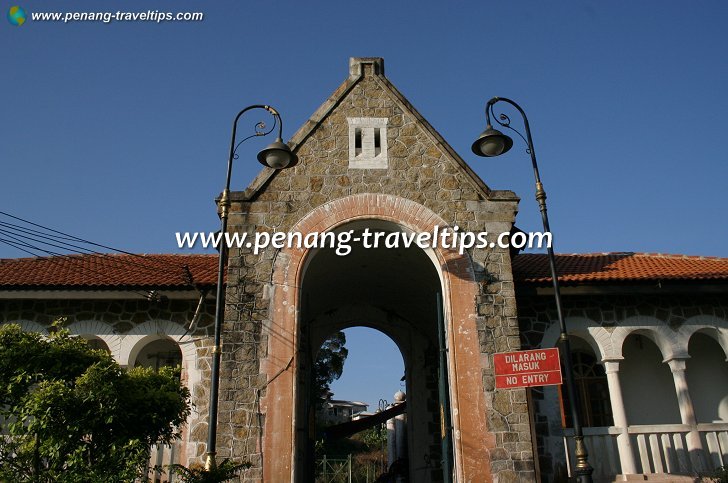
Gateway to Bel Retiro (5 March 2005)
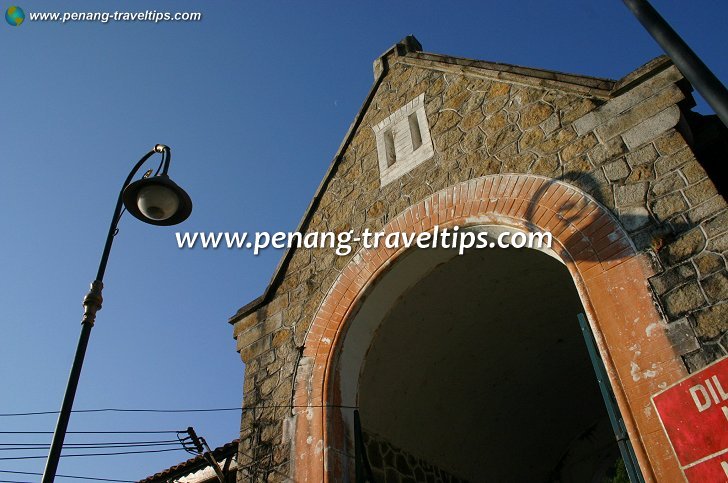
Another view of the gateway to Bel Retiro (5 March 2005) |
|
|
|
|
|
|
|
|
|
|
|
Bellevue Penang Hill Hotel
Bellevue Penang Hill Hotel is the highest hotel in Penang, located at 830 meters above sea level at Halliburton's Hill, a mount within Penang Hill. It is a place to enjoy the old world charm of colonial Penang, enjoying scones, buttered toast, jam, half-boiled eggs, and sipping Darjeeling tea, a feeling that is duplicated at other hillstations in Malaysia, such as at Ye Olde Smokehouse in Cameron Highlands and Fraser's Hill.
The hotel was originally the private residence of William Halliburton, the first Sheriff of Prince of Wales Island under the British East India Company in the early 19th century. The hotel also runs an aviary showcasing a selection of birds.
Getting there
At time of writing (September 2008) the Penang Hill funicular train is again out of operation. Until the hill train is in operation again, the only two ways to reach Bellevue Hotel is by either jeep or by hiking. Coming from the jeep track, look for sign pointing to Bellvue Hotel upon arriving at the peak.
What to see and do
Bellevue Hotel is a place to relax and take things easy. The hotel is particularly pleasant in the early morning, as George Town awakens below. The lawn in front of the hotel offers a splendid view of the city.
Nearby Sights
The following are some of the places you can explore in Penang Hill, arranged in alphabetical order.
Bel Retiro: The most prestigious property on Penang Hill
Bellevue Penang Hill Hotel: Only functioning hotel on Penang Hill
Convalescent Bungalow: One of the oldest rest houses on Penang Hill
Penang Hill Canopy Walk: Abandoned walkway suspended among the trees
Penang Hill Hindu Temple: Temple to Lord Murugan
Penang Hill Mosque: Local mosque for the Muslim community on Penang Hill
Penang Hill Railway: Hill train taking visitors up the hill
Richmond: Rest house belonging to the Municipal Council of Penang Island
Strawberry Hill / David Brown's Cottage: Hillock near the Penang Hill Railway, where plantation owner David Brown built a cottage
The Great Wall: Hill retreat on Penang Hill built by Khoo Sian Ewe

Bellevue Penang Hill Hotel (5 March 2005)
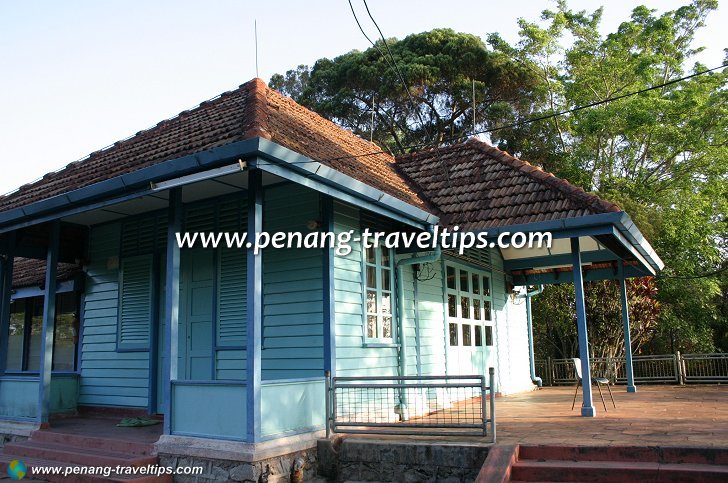
Another view of Richmond MPPP Rest House (5 March 2005) |
|
|
|
|
|
|
|
|
|
|
|
Cheong Fatt Tze Mansion
14 Lebuh Leith, George Town
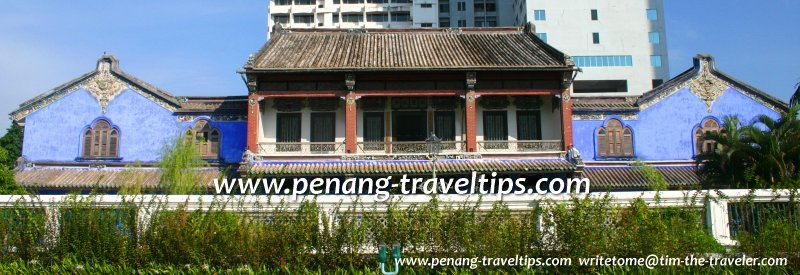
Cheong Fatt Tze Mansion, as seen from Leith Street (28 February 2004)
Cheong Fatt Tze Mansion is an grand Chinese-style mansion along Leith Street (Lebuh Leith) on the buffer zone of the George Town Unesco World Heritage Site. It was built by Cheong Fatt Tze (1840-1916), also known locally as Teow Thiaw Siat, a Chinese of Hakka descent, who was one of the richest men in Southeast Asia.
The Cheong Fatt Tze Mansion was built over a period of seven year between 1897 and 1904. It was one of the many houses belonging to Cheong Fatt Tze, whose property stretched from Java to Sumatra, to Penang, Singapore, Hong Kong and China. But of all these properties, this mansion is his favourite residence. All eight of his sons were raised here and received a Western education at the St Xavier's Institution nearby. The house was also the home for his wives No. 3, 6 and 7.
Cheong Fatt Tze was a Hakka which formed a minority in Penang but welded enormous economic power. Hakkas controlled much of the property and trades in Penang. To the Hokkiens in Penang, Hakkas were called khek lang, meaning "guest people", because they were the latecomers into the Penang society. By the late 19th century and early 20th century, the wealthy Hakkas had turned Leith Street into their own upper crust neighborhood. Apart from Cheong Fatt Tze, a number of Hakkas who were his business associates and relatives also had their homes along Leith Street, including his cousin Chang Yu-Nan, Kapitan China of Medan; Cheah Choon Seng, Kapitan China of Acheh; tin-mining tycoon Leong Fe, who was Cheong's son-in law; and Tye Kee Yoon. But while the rest opted for Western-style mansions, Cheong decided on a very traditionally Chinese look for his home and office.
Despite the decidedly Oriental appearance of Cheong Fatt Tze Mansion (a name given to the mansion only upon its reopening after recent restoration), the fixtures and furnishings were a fusion of Oriental and Western architectural concepts. As you explore the mansion, you will find Chinese-style doors, filigree and latticework placed side-by-side to contemporary louvred windows, stained-glass windows, and floor tiles imported from Stoke-on-Trent in Staffordshire, England.
Cheong Fatt Tze Mansion occupies a land area of 56,000 square feet, with a built-up area totalling 33,000 square feet. In addition to the mansion, Cheong Fatt Tze's residence complex also includes the five terrace houses on the opposite side of Leith Street facing the mansion. These houses were the living quarters of his maids, gardeners, cooks, stable-boys, grooms, and even the concubines and handmaidens who were out of favor. Occupants of the complex can more or less determine where they stand with the master of the house by how close he stationed you from his centre of power.
Cheong Fatt Tze's mansion and the five terrace houses are not aligned to Leith Street. The street had been around much earlier, having been built in the early part of the 19th century, and named after the George Leith, the Lieutenant-Governor of Penang from 1800 to 1803. The reason for the mansion's alignment has to do with Cheong Fatt Tze's belief in feng shui. Before the house was put up, a master geomancer would have done the due diligence to find the best placement for it. This includes the direction of the wind, and how water will be channeled as it passed through the house. All this to ensure that every possible step is taken to ensure that the wealth is retained.
Due to the firm observance of feng shui, Cheong Fatt Tze Mansion is fronted by a rhombus-shaped garden. Within the mansion itself, however, everything was symmetrical. The main building was erected first, centred on an inner courtyard which is where, according to geomancy, all the "qhi" or "energy" eminates. The left and right wings of the mansion were only added at a later stage.
Cheong Fatt Tze went to great length to ensure that the mansion remained within his family after his demise. He put together a will that prevented its sale until the last of his many sons had died. He also put aside funds to ensure that the house is properly maintain. Sadly, it was all an exercise in futility. Unlike the Rockefellers, the Cheong clan did not inherit the patriach's financial acumen to maintain his business empire. The money set aside for the maintenance of the mansion were not sufficiently disbursed. Also, it was a fixed amount was did not take inflation into account. Over time, there was never enough money to keep the mansion in proper repair. Cheong's last daughter-in-law, Thong Siew Mee, lived by her own wits in trying to make ends meet and still upkeep the huge mansion. She was forced to let out rooms, corridor spaces, halls, stores, every inch of the mansion that could earn her rental.
With the death of the last son, Kam Loong, in 1989, the trust under which the mansion was held was finally terminated, and sad to say, the mansion was put up for sale. Fortunately, a group of local conservationists stepped forward to buy it up, fearing that it would be demolished otherwise. The mansion was then restored, bit by bit, from top down, employing techniques that are sympathetic to the traditional methods in which the mansion was first constructed. As the conservationists peeled away the years of neglect, they made startling discoveries about the mansion and the secrets of its workmanship.
Restoration work on Cheong Fatt Tze Mansion begain in 1991, and was completed in 1995. The restoration project was documented and submitted to Unesco Asia-Pacific, which awarded it the "Most Excellent Project" award for cultural heritage conservation.
Today, the mansion is given the name "Cheong Fatt Tze Mansion", after its founder. It has been readapted as a boutique hotel. It is one of the few private residences of its kind outside of China, and is one of the two by the Cheong Fatt Tze clan. In Medan, Indonesia, stands a similar mansion by Cheong Fatt Tze's nephew, Tjong A Fie, who is also an imminent personality there. The Tjong A Fie Mansion is also a tourist attraction in Medan.
Getting There
Cheong Fatt Tze Mansion is located along Lebuh Leith, near to Lebuh Farquhar. The nearest bus stops are at Jalan Penang and Lebuh Farquhar. Rapid Penang buses that stop nearby include T10 and U103.
What to See
The ornamental entrance archway,
The decoration on the roof and walls made of tiny pieces of broken pottery called chien nien
Admire the exterior blue wall finishes made from indigo lime wash
Inside the mansion, view the trompe l'œil painting on the interior dado.
Art Nouveau stained glass windows
Nearby Sights
Hainan Temple
St Francis Xavier Church
Eastern & Oriental Hotel
St Xavier's Institution
Convent Light Street
Church of the Assumption
Associated Sights
Cheong Fatt Tze Mansion in AsiaExplorers
Tjong A Fie Mansion in AsiaExplorers
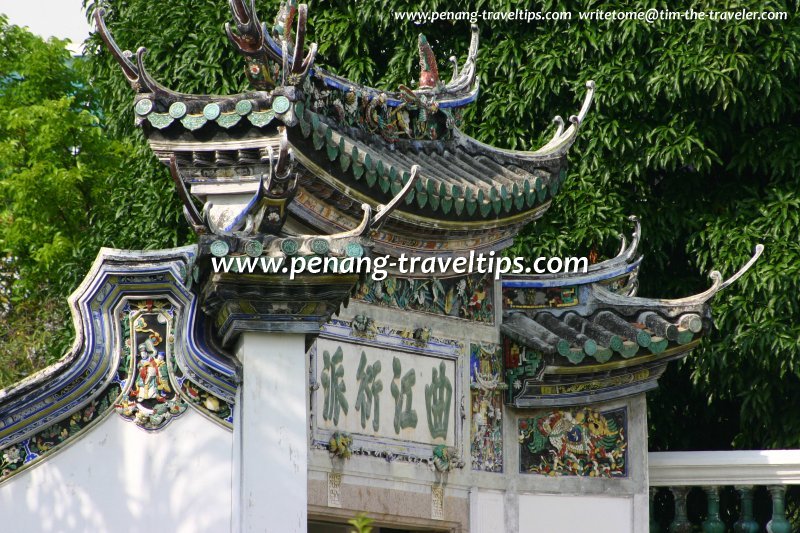
Roof design of Cheong Fatt Tze Mansion gate (28 February 2004)
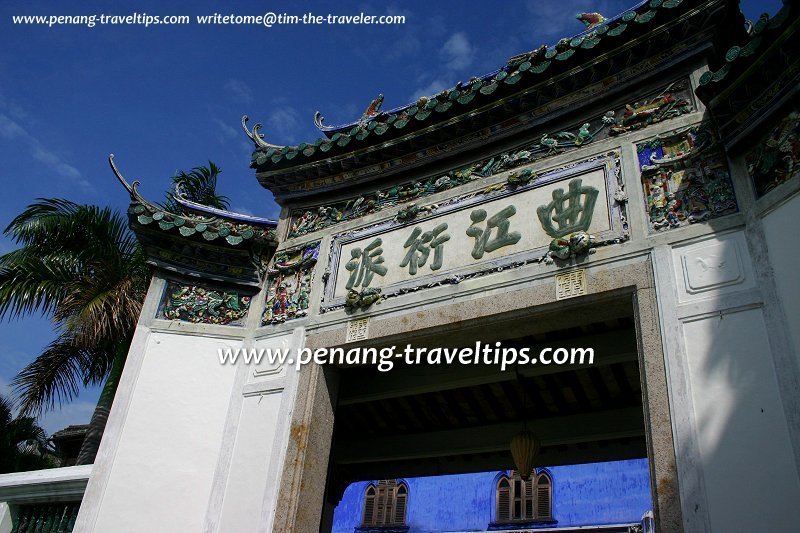
Cheong Fatt Tze Mansion, entrance archway (28 February 2004)
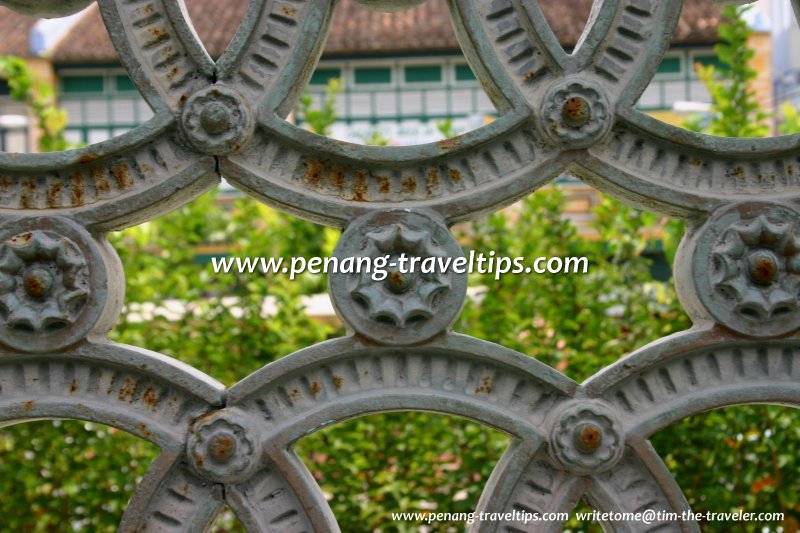
Cheong Fatt Tze Mansion, fence with coin motif (28 February 2004)
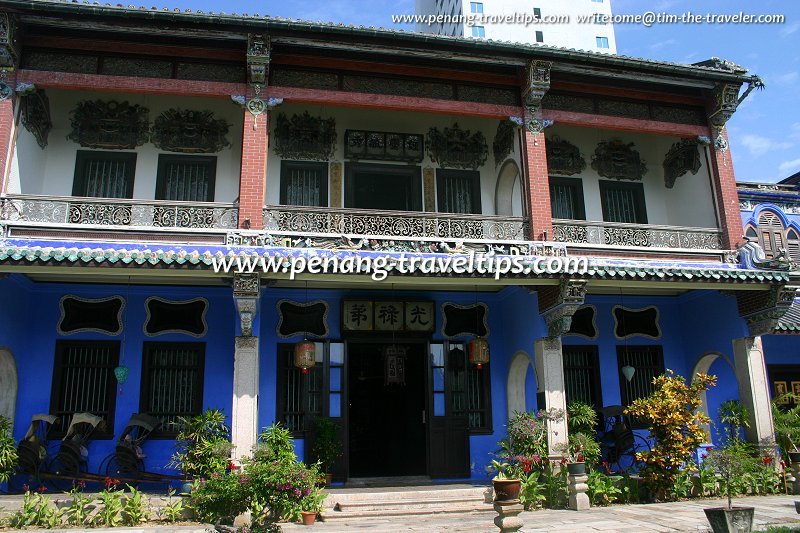
Cheong Fatt Tze Mansion, main building (28 February 2004)
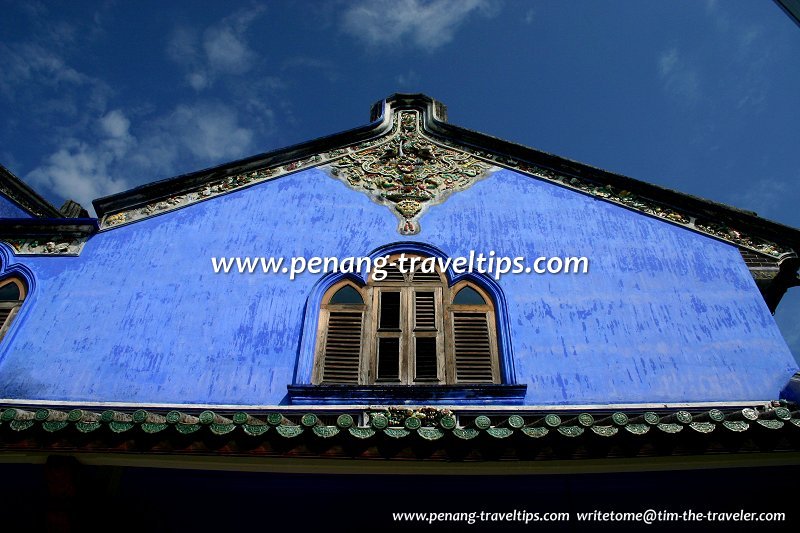
Cheong Fatt Tze Mansion, gable ornamentation (28 February 2004)
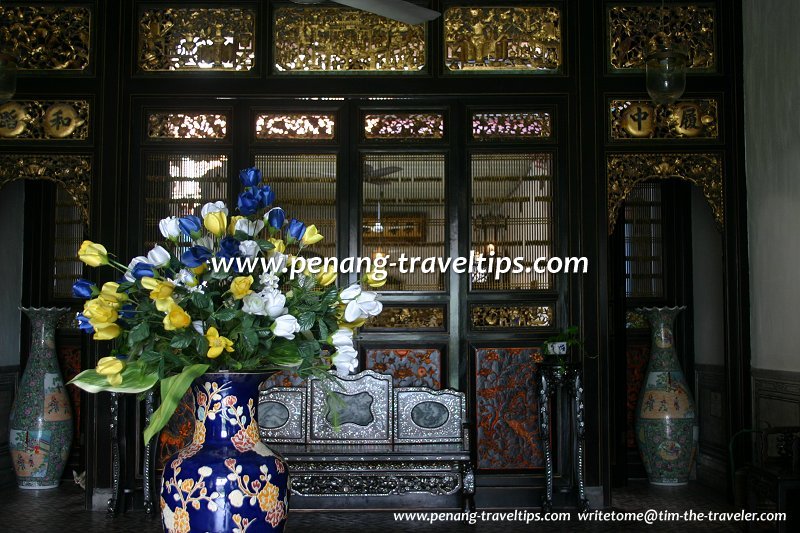
Cheong Fatt Tze Mansion, reception hall (28 February 2004)
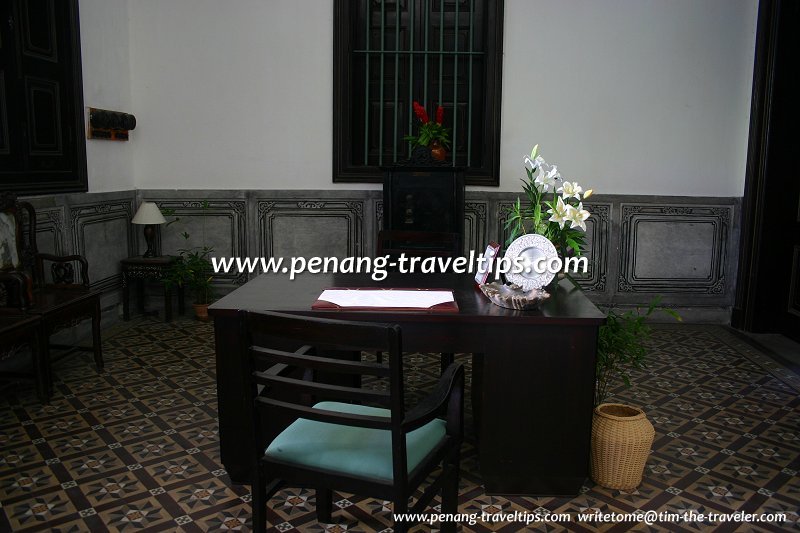
Cheong Fatt Tze Mansion, reception desk (28 February 2004)
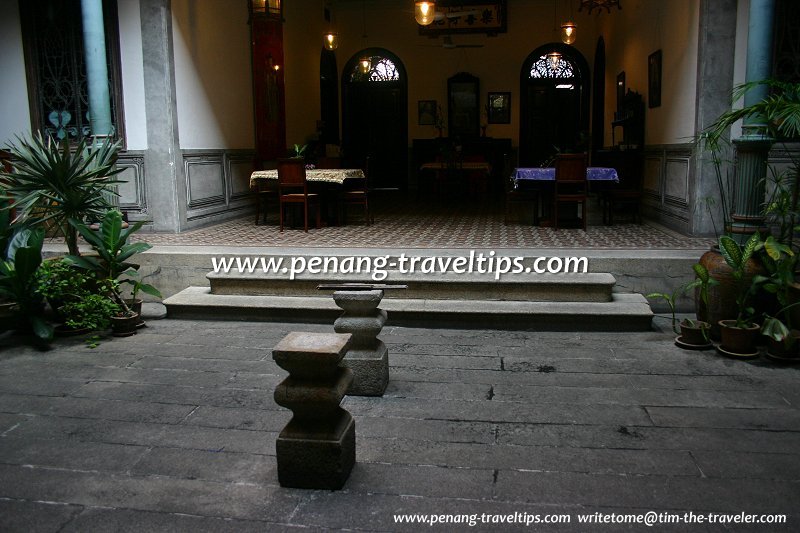
Cheong Fatt Tze Mansion, central courtyard, where some can feel the "qhi" or "energy" (28 February 2004)
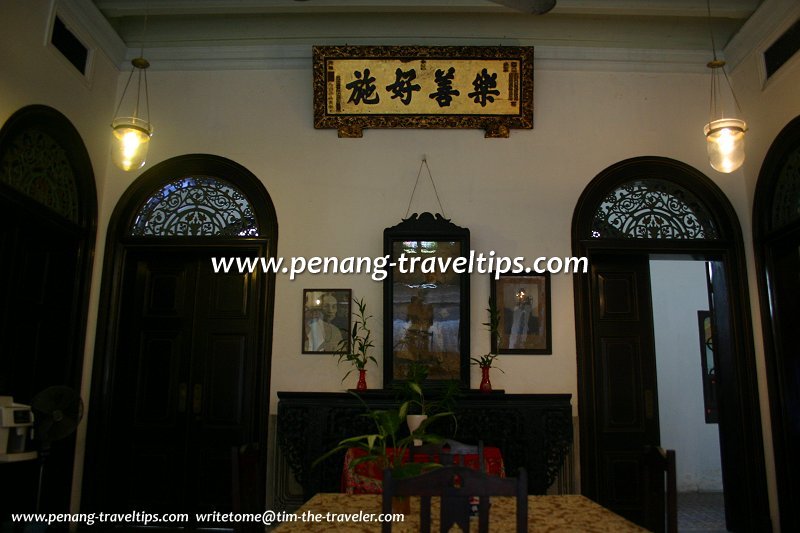
Cheong Fatt Tze Mansion, dining room (28 February 2004)
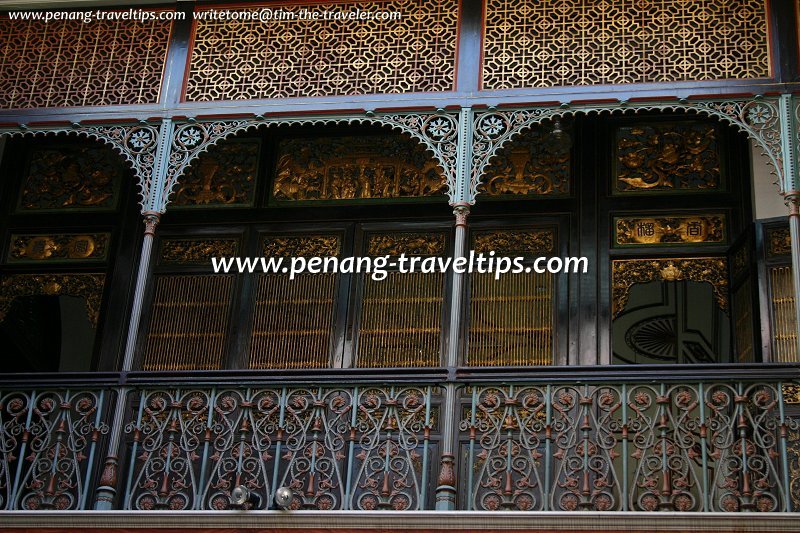
Cheong Fatt Tze Mansion, cast-iron columns, originally by MacFarlanes foundry of Glasgow, Scotland (28 February 2004)
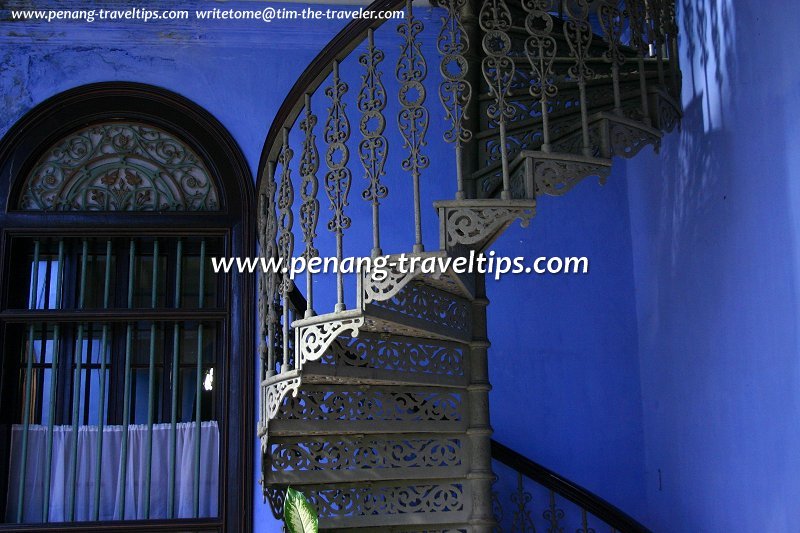
Cheong Fatt Tze Mansion, cast-iron spiral staircase (28 February 2004)
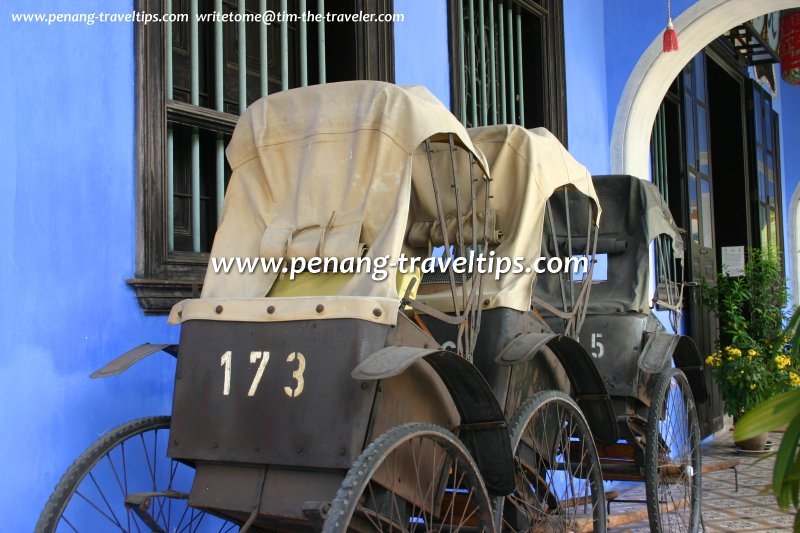
Cheong Fatt Tze Mansion, antique rickshaws (28 February 2004)
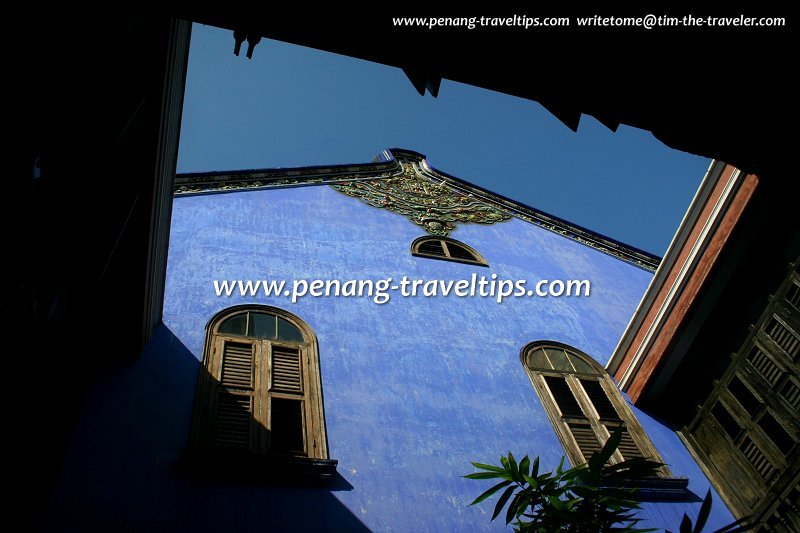
Cheong Fatt Tze Mansion, view from the side wings (28 February 2004) |
|
|
|
|
|
|
|
|
|
|
|
Cherok Tokun Relics
Bukit Mertajam, Penang
Cherok Tokun Relics are ancient inscriptions on a rock in Bukit Mertajam, Penang. Also called Batu Bersurat Cherok Tokun, it is the only ancient megalith in Penang, Malaysia, as recognised by the Malaysian Department of Museum and Antiquities. The granite megalith is located at the foot of Bukit Mertajam, within the compound of the St Anne Church. To reach it, walk across the driveway from the new St Anne Church.
The Cherok Tokun Ancient Inscriptions were first documented by Colonel James Low, a British army officer, in 1845. In his log, Low recorded his disappointment of not finding a more spectacular ruin, expecting to find an ancient temple ruin. He documented what he made out to be "a group of seven inscriptions". The inscriptions were believed to be in pre-Pallava script and written in Sanskrit. They were attributed to the ancient Kingdom of Kadaaram, which flourished in northern Malaysia in the 5th to 6th centuries. However, according to J Laidlay, who translated the text in 1848, the inscription was Pali, not Sanskrit.
The Museum and Antiquities Department built a shed over the megalith in 1973. It was the first and only ancient relic in Penang to be gazetted. By that time, the megalith was already covered with graffiti added by latter-day visitors, including an inscription by Colonel Low himself.
Bibliography
The Malay Peninsula: Crossroads of the Maritime Silk Road (100BC-1300AD) by Michel Jacq-Hergoualc'h
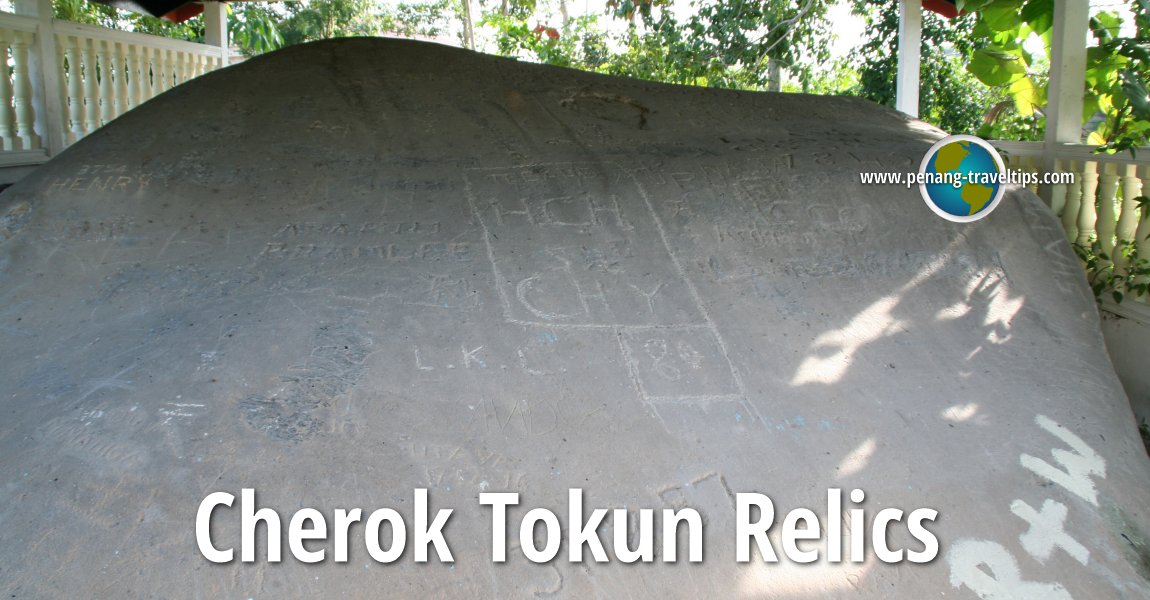
Cherok Tokun Relics
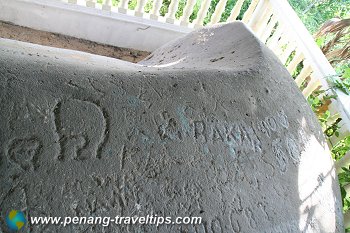
Cherok Tokun Relics close-up
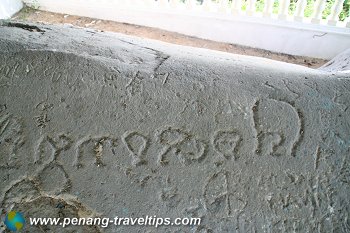
Ancient inscriptions of Cherok Tokun
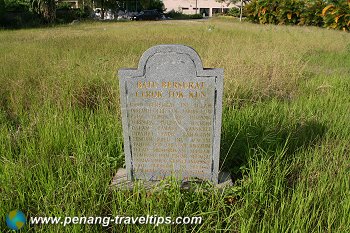
Cherok Tokun plaque |
|
|
|
|
|
|
|
|
|
|
|
Chew Jetty
Pengkalan Weld, George Town
Chew Jetty, or Seh Chew Keo, is the biggest of the waterfront settlements in George Town. It was created in the middle of the 19th Century, in a very different Penang from what it is today. The last community jetties, the Peng Aun and the Chap Seh Keo, were only established in the 1960's. Each of the clan jetties has a small shrine to pay homage to the sea deities. Chew Jetty is the only clan jetty left that continues to have observe the once a year annual worship of its Temple Deity and the Jade Emperor (Thnee Kong, or "god of the skies")
Like gnarled fingers that claw the sea, clan jetties line the water front of Georgetown. Here, we find a community that has existed for over a hundred years, suspended in time above the tide lines. Today, however, encroaching development poses a formidable threat to the very existence of this unique waterborne community.
On March 20, 2004, members of AsiaExplorers paid a visit to Chew Jetty. It was part of our exploration to better appreciate the heritage sites of Penang. For the unfamiliar, the Clan Jetties consist of seven sets of wooden piers. They are home to seven clans who migrated from China: the Lims, Chews, Tans, Lees, Yeohs, Koays and one mixed jetty. The visit was hosted by Chew Siew Pheng, an AsiaExplorers member who happens to be a resident of her namesake jetty.
Getting there
You can walk to Chew Jetty from the Weld Quay Bus Terminal, a distance of 250 meters (800 ft). From the bus terminal, walk south along Pengkalan Weld until you reach Chew Jetty (with posted signboard) on your left.
Nearby Sights
Wisma Kastam (Malayan Railway Building)
Tan Kongsi
Yeoh Kongsi
Cheah Kongsi

Chew Jetty at dusk.

Time to unwind.

In the cool of the evening.

City life: an otter relaxes at Chew jetty, within view of the second busiest harbour in Malaysia.

Plankway leads to a home with a family altar. |
|
|
|
|
|
|
|
|
|
|
|
Chinese Chamber of Commerce
3, 5, 7, 9 & 11, Lebuh Light, George Town
The Chinese Chamber of Commerce building is a heritage building facing Light Street in George Town, Penang. The building is wrapped around the corner from Penang Street to Light Street with a colonnaded five-foot way on the outside. It was designed by a local architect, Chew Eng Eam in 1926. On the rooftop is an open air verandah with splended views of the greens of Esplanade or Padang Kota. The building carries ornamentations in the form of urns, corbels, terrace balustrades and mock Tudor gable.
The Chinese Chamber of Commerce building is located on the opposite side of Penang Street from Foo Tye Sin Mansion, which was owned by one of the wealthiest persons in Penang in the late 19th century.

Chinese Chamber of Commerce, Penang. |
|
|
|
|
|
|
|
|
|
|
|
Church Street Pier
Pengkalan Weld, George Town
The Church Street Pier is a heritage pier on the George Town waterfront. For many years it was a run-down, abandoned pier, but recently it was refurbished. Built in 1897, the Church Street Pier hails from a more romantic era when the Penang Channel was a much busier waterway. You can stand on the pier and imagine the waterfront choked full with sampans, perahus, junks, steamships and cruise vessels of varying sizes. Today the scene at the harbour would seem more orderly and perhaps less picturesque.
Before the construction of the present ferry terminal, the Church Street Pier was used by motorcars. After that, it was used by small boats, before eventually closing down, a fate shared by other similar jetties that used to line the waterfront. Among the jetties that are now history include the Railway Jetty at China Street Ghaut and the Victoria Pier at Downing Street Ghaut.

Church Street Pier

Another view of the Church Street Pier, this one in the direction of George Town. |
|
|
|
|
|
|
|
|
|
|
|
City Hall
Jalan Padang Kota Lama, George Town, Penang
The City Hall of George Town is a handsome Victorian-style building constructed in 1903, and opened in 1906, a few decades after the Town Hall. It holds the distinction as being one of the first buildings in George Town, Penang, to be completely fitted with electric lights and fans. Pioneering the electrification of George Town was the company of August & Ludwig Huttenbach, the German brothers who formed the firm Huttenbach Brothers. I photographed the City Hall, along with the Town Hall, as part of the documentation for the AsiaExplorers George Town Colonial Heritage Self-Guided Tour.

George Town City Hall (Dewan Bandaraya George Town).
The City Hall overlooks the historic parade ground at Padang Kota Lama, and affords a panoramic view of the Esplanade. Within a stone's throw from the City Hall is the Cenotaph, the First World War Memorial.

View of the City Hall taken at early morning.

Another view of the City Hall |
|
|
|
|
|
|
|
|
|
|
|
Clan Jetties of George Town
Pengkalan Weld, Penang
The Clan Jetties along the waterfront of George Town, Penang, represents a unique settlement created by Chinese immmigrants who share common historical, geographical and lineage origin. Today there are still eight clan jetties along the waterfront, namely the Seh Lim Keo, Seh Chew Keo, Seh Tan Keo, Seh Lee Keo, Chap Seh Keo, Seh Yeoh Keo and Seh Koay Keo. Some of these clan jetties are in grave danger of being demolished for urban renewal.
Apart from Chap Seh Keo, with its mixed clanage, the rest used to be exclusively inhabited by its respective clansmen. Thus is the distinctive identity of the George Town jetty communities, including the Noordin Ghaut Jetty, Peng Arn Jetty and Ban Liaw Jetty , which are all located further south, along the Jelutong seafront. Collectively, they constitute Penang's waterfront society. There used to be more community jetties along the waterfront, including the Poh Lan/Lallang Jetty, Hup Choon Jetty, old Lee Jetty and the old Ong Jetty, all of which have been erased by time.

Clan jetties along the George Town waterfront.

Main door of a clan jetty home.

A less appealing perspective to jetty living.

View of Koay Jetty with the city of George Town in the background.

Bridging the gap of time. |
|
|
|
|
|
|
|
|
|
|
|
Eastern & Oriental Hotel
E & O Hotel, Lebuh Farquhar, George Town
The Eastern & Oriental Hotel along Farquhar Street, George Town, is one of the most elegant hotels in the Orient. Often called the E & O, it was the first of a chain of hotels founded by the four Armenian brothers, Martin, Tigran, Aviet and Arshak Sarkies, collectively known as the Sarkies brothers. Some of the best known hotels in the Far East were started by them, including the Raffles Hotel in Singapore and the Strand, in Rangoon, Myanmar. By 1892, the brothers were spread across Southeast Asia. The youngest, Arshak Sarkies, took up the management of the E & O while Tigran Sarkies manages the Raffles Hotel and Aviet was stationed in Rangoon. The eldest, Martin Sarkies, has by then retired.
The idea to set up the hotel business came about in 1885 when the Sarkies brothers met the Khaw family in Bangkok, and was encouraged by them to set up a hotel in Penang. The Khaws built two separate hotels which the Sarkies managed. These were the Eastern Hotel, completed in 1884, and the Oriental Hotel, in 1885. It became immediately apparent that these two hotels should be combined, and hence the Eastern & Oriental Hotel was formed. In addition, the Sarkies also managed the Crag Hotel on Penang Hill.
The merger of these two hotels created one of the finest hotel establishments in the region. It boasted of having the world's longest sea-front lawn, which is 842 feet in length. Famous personalities who arrived at the E&O (many of whom also turned up at the Raffles Hotel) included Noel Coward, Douglas Fairbanks, Hermann Hesse, Rudyard Kipling and Somerset Maugham.

Eastern & Oriental Hotel, Farquhar Street, Penang.

View of the sea from the Eastern & Oriental Hotel. |
|
|
|
|
|
|
|
|
|
|
|
Farquhar Street Mission House and Chapel
35 Lebuh Farquhar, George Town
Farquhar Street Mission House and Chapel, at 35 Lebuh Farquhar, is one of the earliest premises of the brethren assemblies in this region. Today, what remains is Mission House, a dilapidated house located on the opposite side of Farquhar Street from The Promenade annex of the Eastern & Oriental Hotel. The brethren assemlies initiated at Farquhar Street Mission House and Chapel survives today as Burmah Road Gospel Hall and its sister assemblies in Penang, as well as in other brethren assemblies in Malaysia and Singapore.
Mission House was built by William Macdonald, a missionary of the Brethren assembly, between 1876 and 1878. It stands on a piece of land that an earlier missionary, Johann Georg Bausum @ John George Bausum, had purchased for the extension of the school that was founded by his first wife, Maria Dyer Bausum. The building was used until 1938, when the church moved to its new premises at Jalan Burma, where it was called Burmah Road Hall, and today, Burmah Road Gospel Hall.
There used to be another building, Mission Chapel, that stood next to Mission House. It was demolished when Lebuh Farquhar was widened in 1939.
Author's Note
My great grandmother, grandmother and mother worshipped at the Mission Chapel at 35 Farquhar Street, George Town, during the early part of the 20th century. At that time, my grandmother was staying in Air Itam. She would take my mother, who was still a small girl, to attend church at 35 Farquhar Street. They would take the tram to George Town. After my great grandmother and grandmother had passed on, my mother continued to worship at Burmah Road Hall. She was married there in 1947. My parents continued to worship there until the early 1970's when they moved to worship at Island Glades Gospel Centre, an offshoot of Burmah Road Gospel Hall. I started attending Sunday School and church there, until the early 1980's, when we moved to another spin-off branch, Sungai Nibong Gospel Hall.
I was unaware that original Mission House in Farquhar Street is still standing until I embark on a historical documentation of the heritage sites within George Town.
Getting there
The Mission House building is located along Lebuh Farquhar. Using the E&O Hotel front entrance as starting point, cross Lebuh Farquhar to The Garage. Turn right and go along the sidewalk at The Garage and you will arrive at the Mission House which is on the left side of the road. The address, No. 35, is still visible at the gate.
What to see and do there
The Mission House is pregnant with history, but has no touristic value. It is presently overgrown with shrubs. The grass is long and uncut. There is nothing here to interest the average tourist, unless the person has an interest in visiting a site where early Christian mission work in Penang was carried out in the 19th century.

Farquhar Street Mission House and Chapel is a dilapidated house along Lebuh Farquhar

35 Farquhar Street, the Farquhar Street Mission House and Chapel, covered in undergrowth |
|
|
|
|
|
|
|
|
|
|
|
Foo Tye Sin Mansion
Lebuh Light, George Town
The Foo Tye Sin Mansion is one of the first non-European mansions to be erected along Light Street. Until the time it was built, around the mid 19th Century, Light Street was the preserve of the European elite. Foo Tye Sin was one of three Chinese tycoons who were given the honour of sitting on the Commission of Inquiry into the 1867 Penang Riots. Foo Tye Sin, whose name today graces Tye Sin Street, is one of those newly rich, British-educated Chinese. Foo Tye Sin was born in Penang and educated at the Penang Free School. His business partner was Koh Seang Tat, who built the Koh Seang Tat Fountain beside the Penang Town Hall. Together, they were two of the three Chinese Justices of the Peace in 1874.

Foo Tye Sin Mansion today houses a local bank.
Although the colonial administrators think of him as a Hai San sympathiser, he was nevertheless the only non-partisan Chinese at a ceasefire conference called by Lt. Governor Anson at the height of the Larut war.
A charming feature of the Foo Tye Sin Mansion is the fourth storey lookout tower at the back, today unused. The mansion itself has since been converted to house a branch of a local bank.

Side of the Foo Tye Sin Mansion where the 4th storey lookout tower is visible. |
|
|
|
|
|
|
|
|
|
|
|
Fort Cornwallis
Padang Kota Lama, George Town
Fort Cornwallis at Padang Kota Lama, George Town, is the largest intact fortress still standing in Malaysia. When Captain Francis Light landed in Penang in 1786, on the cape which today becomes George Town, he built a simple stockade out of nibong palms. The tip of Penang Island where Fort Cornwallis was located was called Fort Point. Fort Cornwallis was named after the Governor-General of Bengal, Charles Marquis Cornwallis. Since the late 19th century, a lighthouse stands on the northeast side of Fort Cornwallis, and is today known as the Fort Cornwallis Lighthouse.
Three years later, in 1789, with convict labour imported from India, Francis Light rebuilt Fort Cornwallis in bricks in the same star-shaped size and layout. The total cost of the reconstruction, completed in 1793, was 67,000 Spanish Dollars. Cannons were mounted along the perimeter.
The most famous cannon at Forn Cornwallis is the Seri Rambai. This particular cannon has a fascinating history. It was first presented by the Dutch to the Sultan of Johor in 1606. In 1613, the Portuguese took possession of Seri Rambai. Then it was taken to Java, where it stayed until 1795, when it was given to Acheh, and was brought to Kuala Selangor. Later, in 1871, the British seized the cannon and brought it over to Penang. It was installed on Forn Cornwallis, where it is still located, on the northwest bastion. Locals believe that Seri Rambai possesses magical powers, and that women who place flowers on the barrel will improve their fertility.
Forn Cornwallis was originally encircled by a 27-feet wide, 6-feet deep moat. It was filled up in the 1920s to prevent malaria (there was an epidemic which hit Penang then).
Fort Cornwallis was the first military and administrative base of the British East India Company. The East India Company was started in the early 17th century. On 31 December 1600, a group of British merchants were given monopoly privileges on all British trades with the East Indies, and the East India Company was started. Over the years, their business activities boomed.
The East India Company traded in spices such as cloves, nutmeg and peppercorns. In the later half of the 18th century, the East India Company managed to obtain a monopoly on the trade in silk, with Canton (Guangzhou), China. However, there was no refueling station between China and the British base in India. Hence there was a need to find a suitable port for the British vessels to stop over.
The East India Company first took steps to find a base in Southeast Asia in 1763, but the missions were unsuccessful. The Director of the East India Company sent a message to the Madras Council to try once again to secure a settlement in or near the Straits of Malacca. While the message was still in passage, something else happened to helped the British secure the settlement they were seeking.
Captain Francis Light, a seaman who has established a trading station in Kedah for the Madras firm of Jourdain, Sullivan and De Souza put together a plan that practically solved the problem. Light suggested that the island of Penang would be a suitable station for the East India Company. At the same time, Light reported to his superiors at the Madras firm that the King of Kedah had granted him Kuala Kedah as well as the entire coast including Penang Island, in return for protection against Selangor. However, after a few letters to his superiors and having been ignored in these negotiations, a bitter Francis Light withdrew to Phuket. He continued his trading activities and maintained his relationship with the ruler of Kedah. On 15 February 1786, he wrote to the acting Governor-General of India, on the success of his mission in getting Penang, and on 11 August 1786, Francis Light took formal possession of Penang Island.
For other mentions of Captain Francis Light in AsiaExplorers, refer to the following pages:
Francis Light Tomb
Francis Light Statue
Suffolk House
Francis Light Memorial
Phuket

Reconstruction of the camp set up by the British upon landing in Penang, on the grounds of Fort Cornwallis.

Entrance to Fort Cornwallis.

View of the Seri Rambai.

The Fort Cornwallis Lighthouse.

Statue of the Man. When a bronze statue of Captain Francis Light was cast in 1978, the sculptor F.J. Wilcoxson had no photograph or painting of Light to use as model, so he based it on the painting of Francis Light's son, William Light, the founder of Adelaide.

In an effort to create a living museum, staff in period costume is employed.

The store, on the southwest part of Fort Cornwallis.

Pillbox shape of the Gunpowder Magazine.

Entrance to the Gunpowder Magazine.

Fort Cornwallis Chapel. |
|
|
|
|
|
|
|
|
|
| |
Category: Negeri & Negara
|